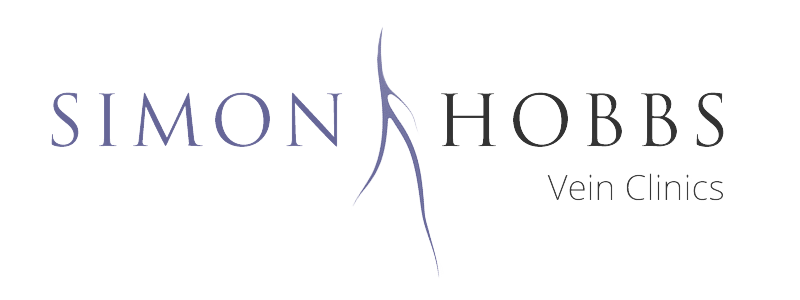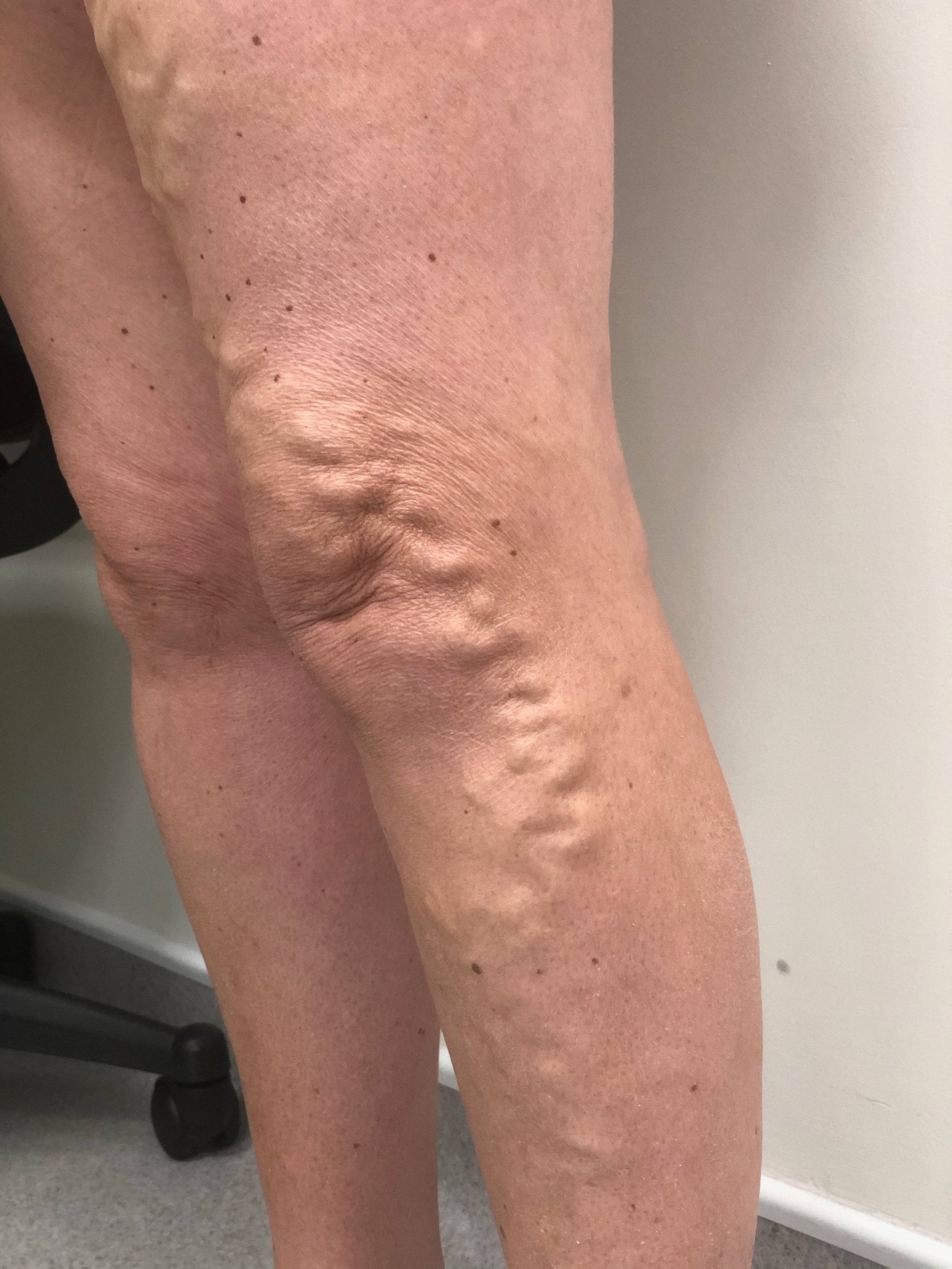
Varicose Vein Symptoms
Varicose Veins can produce a wide range of symptoms and can have serious health consequences
Varicose Vein Symptoms
Some people come and see us simply because their veins are unsightly, however, varicose veins are more than just a cosmetic concern. While the hallmark sign is the visible appearance of enlarged, twisted veins, individuals with varicose veins often experience various uncomfortable symptoms. These can include aching or throbbing in the legs, a heavy or restless leg sensation, and cramping. Some people may notice discolouration of the skin near the affected veins or ankle or swelling of the foot and ankle. Symptoms tend to worsen after prolonged periods of standing or sitting and can be helped by the wearing of compression hosiery.
Understanding and addressing these symptoms is crucial, as untreated varicose veins can lead to complications. If you experience these signs, it’s advisable to seek medical advice for an accurate diagnosis and appropriate treatment.
Symptoms from high pressure in your veins can occur even without visible varicose veins - if you are worried, a simple ultrasound scan is all that is needed
Learn about Varicose Vein symptoms
Most leg symptoms due to venous problems are caused by the high pressure in the veins - this is why vein symptoms are often worse towards the end of the day, after you have spent many hours sitting or standing. These symptoms can even persist after getting into bed at night time with many patients reporting that this is the time when their legs feel most achy or restless. Most symptoms have usually settled by the time you get up in the morning having spent time overnight with your legs elevated.
Click on the links below to learn more about specific symptoms.
-
The pain caused by varicose veins varies from person to person. A large study in Edinburgh identified the following as common symptoms of varicose veins.
Heaviness; tension; itching; swelling; aching; throbbing; restless legs; tingling; cramps
-
Itching is the result of a localised area of chronic inflammation in the skin overlying varicose veins. In more severe cases varicose eczema can develop.
-
Venous eczema (also called stasis dermatitis) is the result of long-term exposure of the skin to the high pressure in the veins that occurs with venous disease. It presents as dry, scaly itchy areas on the skin - usually below the knee. Whilst it can appear directly over a varicose vein it is also commonly seen over the ankles or shin.
Sometimes the eczema can result in a break in the skin that can become infected.
-
Restless legs, are often linked to varicose veins and can be a frustrating and uncomfortable experience. These sensations typically occur when individuals are at rest, leading to an irresistible urge to move their legs.
-
Swelling of the ankles is a common symptom of venous disease and generally gets worse throughout the day. It is usually first noticed as a visible indent at the top of your sock line when you remove your socks in the evening.
Swelling due to vein problems usually settles when you elevate your legs and is not generally present first thing in the morning as your legs have been elevated to the level of your heart in bed at night.
In more severe cases the swelling can become more permanent and may not fully resolve with elevation.
Watch the video to hear how Wendy felt about her varicose veins, what motivated her to seek medical help and the benefit that she enjoyed following successful treatment
Struggling with vein symptoms? Our top tips to ease discomfort and some more myths
What can i do to help my vein symptoms?
Whilst none of these will repair the damaged valves in your legs there are several things that you can do at home to help you manage the symptoms that associated with your veins.
-
Exercise plays a crucial role in maintaining healthy veins. Even simple walking promotes better circulation, strengthens the calf muscles that assist blood flow back to the heart, reduces pressure on the veins, and helps control weight, all of which collectively contribute to preventing vein-related issues.
It your job involves sitting or standing for log periods make sure you have regular short walks to assist the calf-muscle pump to reduce the stagnation of blood in the veins of the leg.
-
Maintaining a healthy weight is essential for vein health. Excess weight puts added pressure on veins and a large abdomen can cause significant pressure of the veins in the groin, increasing the pressure further down the leg.
We see many overweight patients with classical signs of venous disease in the legs including skin staining and ulcers in the absence of any of the typical valve problems we see in patients with varicose veins.
A balanced weight helps reduce strain on the veins, promoting better blood flow and overall vein health. Loosing weight If you are overweight is the single biggest intervention that you can do to reduce your symptoms and lower your risk of long term leg problems.
-
We have previously discussed the link between faulty valves and the effect of gravity resulting in the high pressure in the leg veins responsible for many of the symptoms people experience.
Leg elevation is a simple yet effective technique to alleviate vein-related symptoms. Elevating your legs above heart level assists in reducing pressure in the leg veins, aiding blood flow back to the heart and reducing the swelling and discomfort associated with varicose veins.
-
While moisturising creams won't directly treat vein problems, they can help with the skin dryness or itchiness often associated with varicose veins. Look for creams with ingredients such as aloe vera or vitamin E to soothe the skin, but for vein issues, it's best to seek medical advice for more effective treatments.
Active areas of venous eczema may benefit from a steroid cream but these should not be used on a regular basis as thinning of the skin can occur.
-
Properly measured, graduated compression stockings are really useful in tackling some of the symptoms that vein sufferers experience. They help to prevent the pooling of blood in the leg by effectively squeezing it back towards the heart against gravity.
They are also essential in those patients who already have established skin damage as a result of their venous disease.
Due to the importance of compression hosiery in managing venous disease we will cover this further in our section covering treatments for varicose veins.
-
A quick Google search will identify a large number of natural home remedies that are reported to help with varicose veins from apple cider vinegar, olive oil, garlic ointments, witch hazel and horse chestnut extract.
Many of these are reported to have anti-inflammatory properties that can help with some of the symptoms of venous disease. None however have been shown to be effective in the medical literature.
These remedies do not deal with the underlying problem of faulty valves in the veins and if any benefit, if seen, is more likely to be due to the massaging and moisturising effects rather than any magical ingredient in the remedy.
Further questions?
Book a consultation?
Click the link to complete our enquiry form and a member of our team will be in touch



